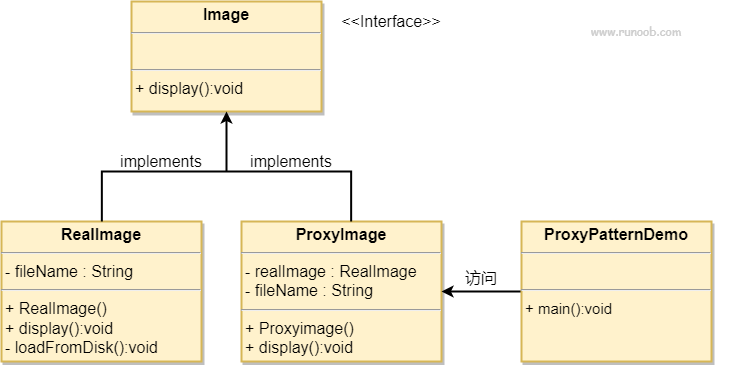代理模式
引用:代理模式、【设计模式】代理模式
介绍
代理模式:为其它对象提供一种代理,以控制对这个对象的访问。
代理对象在客户端和目标对象之间起到中介的作用。
客户端通过代理类与目标对象进行交互,客户端不直接接触目标对象。
如:
租客通过中介找房东租房子,房东将房子托管给了中介,房东是目标对象,但是租赁行为是中介来执行的,中介是代理类,租客就是客户端。
中介代理房东进行租赁行为,相当于代理类对目标对象进行了增强。
示例
我们将创建一个 Image 接口和实现了 Image 接口的实体类。ProxyImage 是一个代理类,减少 RealImage 对象加载的内存占用。
ProxyPatternDemo 类使用 ProxyImage 来获取要加载的 Image 对象,并按照需求进行显示。
 |
步骤 1:定义接口
创建一个接口。
// Image.java
public interface Image {
void display();
}
步骤 2:创建实现类(真实实现类和代理类)
创建实现接口的实现类。
// RealImage.java
public class RealImage implements Image {
private String fileName;
public RealImage(String fileName){
this.fileName = fileName;
loadFromDisk(fileName);
}
@Override
public void display() {
System.out.println("Displaying " + fileName);
}
private void loadFromDisk(String fileName){
System.out.println("Loading " + fileName);
}
}
// ProxyImage.java
public class ProxyImage implements Image{
private RealImage realImage;
private String fileName;
public ProxyImage(String fileName){
this.fileName = fileName;
}
@Override
public void display() {
if(realImage == null){
realImage = new RealImage(fileName);
}
realImage.display();
}
}
步骤 3:使用代理类
当被请求时,使用 ProxyImage 来获取 RealImage 类的对象。
// ProxyPatternDemo.java
public class ProxyPatternDemo {
public static void main(String[] args) {
Image image = new ProxyImage("test_10mb.jpg");
// 图像将从磁盘加载
image.display();
System.out.println("");
// 图像不需要从磁盘加载
image.display();
}
}
执行程序,输出结果:
Loading test_10mb.jpg
Displaying test_10mb.jpg
Displaying test_10mb.jpg

 浙公网安备 33010602011771号
浙公网安备 33010602011771号